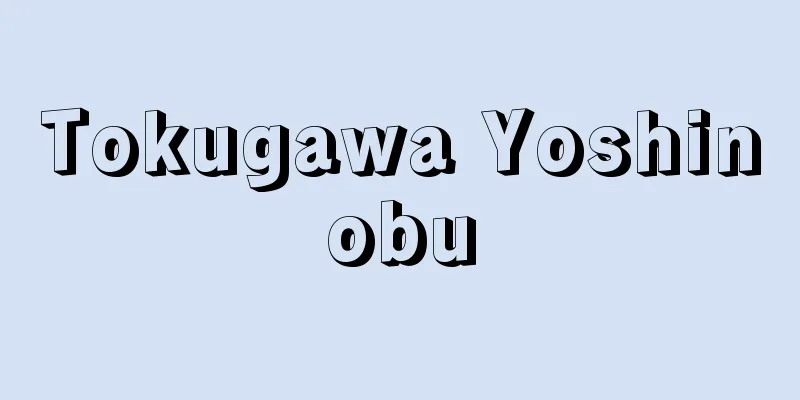Tokugawa Yoshinobu

|
The 15th and final Shogun of the Edo Shogunate. The seventh son of Tokugawa Nariaki, lord of the Mito domain, his childhood name was Shichiromaro or Akimune. His pen name was Shikuni and he was called Gyobukyo. He was born on September 29, 8th year of Tenpo, at the Edo domain residence in Koishikawa. After studying at Mito Kodokan, he inherited the Hitotsubashi family line in 1847 (4th year of the Koka era) and changed his name to Yoshinobu. After Perry's arrival, he was supported by the Hitotsubashi faction, including Matsudaira Yoshinaga, a powerful reformist clan, in the issue of the succession to the shogun, and fought against Tokugawa Yoshitomi (Iemochi), who was supported by the Nanki faction, but was defeated when Ii Naosuke suddenly became the chief advisor in April 1858 (Ansei 5) and decided that Yoshitomi would be the heir. Furthermore, in response to the fact that the Treaty of Amity and Commerce between the United States and Japan was signed without waiting for imperial sanction, Yoshinobu, along with his father Tokugawa Nariaki and Tokugawa Yoshikatsu, the lord of the Owari clan, unexpectedly went to the castle to reprimand the chief advisor, which resulted in him being barred from going to the castle, and he was sentenced to retirement and house arrest during the Ansei Purge the following year. However, after Ii Naosuke was assassinated outside the Sakurada Gate in 1860 (Man'en 1), he was released from house arrest due to the shogunate's policy of appeasement, and then in 1862 (Bunkyu 2), when imperial envoys Ohara Shigetomi and Shimazu Hisamitsu traveled east to demand reforms to the shogunate, he was allowed by imperial decree to reinherit the Hitotsubashi family and was also appointed guardian of the shogun. Thus, the situation changed drastically, and Yoshinobu, together with Matsudaira Yoshinaga, who became Chief Minister of State, rose to the top of the shogunate government, but reforms were difficult. In 1863, in response to the Imperial Court's urging for expulsion of foreigners, Yoshinobu went to Kyoto to negotiate with the Imperial Court to preach opening the country himself, but was instead forced by the Sonno-joi faction to promise that the expulsion date would be May, and returned to Edo. When the Sonno-joi faction was expelled from Kyoto in the coup of August 18 of the same year, Yoshinobu went to Kyoto again, and was ordered to serve as a council member in the Imperial Council along with Matsudaira Katamori, Matsudaira Yoshinaga, Yamauchi Toyoshige, and Date Munenari. However, Yoshinobu, who insisted on shogunate-centered reforms, came into conflict with the other council members, and the council ended in failure. In 1864, Keiki resigned from his positions as counselor and guardian of the shogun and became commander-in-chief of the Imperial Guard, where he played an active role during the Kinmon Incident. The following year, in 1866 (Keio 2), the Eastern Army suffered a series of defeats in the Second Choshu Expedition, and after Iemochi's death, he succeeded him as the 15th shogun in December. He cooperated with France and reformed the military system to a Western style, and also reformed the shogunate system, but he could not turn the tide, and in October 1867, when the secret imperial decree to overthrow the shogunate was issued, he returned the government to the Emperor. He still planned to maintain the power of the Tokugawa clan within the political system of the alliance of various domains, but in December, the Imperial Council, influenced by the anti-shogunate faction, proclaimed the restoration of the monarchy, and at the beginning of the new year, the shogunate forces were defeated in the Battle of Toba-Fushimi. Yoshinobu returned to Edo by sea, and, refusing the urging of the French envoy Roches and others to rise again, moved to Kan'ei-ji Temple in Ueno, expressing his intention to be in self-imposed confinement. After the surrender of Edo Castle, he was in self-imposed confinement in Mito, and, by order of the new government, he handed over the headship of the Tokugawa family to Tayasu Kamenosuke (Iesato) and moved to Sunpu. In 1869 (Meiji 2), he was pardoned and later became a duke. He died on November 22, 1913. [Katsuo Inoue] "The Biography of Tokugawa Yoshinobu, written by Eiichi Shibusawa and commented by Sadafumi Fujii, 4 volumes (Heibonsha, Toyo Bunko)" "The Notes of the Sekumukai Society: Reminiscences of Tokugawa Yoshinobu, edited by Eiichi Shibusawa and edited by Toshiaki Okubo (Heibonsha, Toyo Bunko)" [References] | | |National Diet Library Tokugawa Yoshinobu Note: In the diagram, biological children are indicated with | and adopted children with ‖ ©Shogakukan Tokugawa family (Shogun family) / Brief family tree Source: Shogakukan Encyclopedia Nipponica About Encyclopedia Nipponica Information | Legend |
|
江戸幕府第15代、最後の将軍。水戸藩主徳川斉昭(なりあき)の第7子で幼名七郎麿(しちろうまろ)、または昭致(あきむね)。字(あざな)は子邦、刑部卿(ぎょうぶきょう)を名のる。天保(てんぽう)8年9月29日、小石川の江戸藩邸に生まれる。水戸弘道(こうどう)館で学んだのち、1847年(弘化4)一橋(ひとつばし)家を継いで慶喜と改名した。 ペリー来航後、将軍継嗣(けいし)問題で改革派雄藩の松平慶永(まつだいらよしなが)ら一橋派に推され、南紀派の推す徳川慶福(よしとみ)(家茂(いえもち))と争ったが、1858年(安政5)4月井伊直弼(いいなおすけ)が突如、大老職に就任したあと、慶福を世子に決定したため敗れた。また勅許を待たずに日米修好通商条約に調印したことに対し、慶喜は、実父徳川斉昭、尾張(おわり)藩主徳川慶勝(よしかつ)らとともに不時登城して大老を詰責したために、登城を止められ、翌年の安政(あんせい)の大獄で隠居謹慎の処分を受けた。しかし、1860年(万延1)井伊直弼が桜田門外に暗殺されてのち、幕政の宥和(ゆうわ)方針によって謹慎を解かれ、さらに1862年(文久2)勅使大原重徳(おおはらしげとみ)と島津久光(しまづひさみつ)が東下して幕政改革を迫った際に、勅旨により、一橋家の再相続を許され、同時に将軍後見職に任ぜられた。 かくて事態は一変し、慶喜は、政事総裁職についた松平慶永(よしなが)とともに幕政の頂点にたつことになったが、改革は難航した。1863年、朝廷の攘夷(じょうい)督促に対して自ら開国を説くべく上洛(じょうらく)して朝廷と折衝したが、かえって尊攘派勢力の工作によって攘夷期日を5月と約束させられて江戸に帰った。同年八月十八日の政変により、京都から尊攘派が排除されると再度上洛し、松平容保(まつだいらかたもり)、同慶永、山内豊信(やまうちとよしげ)、伊達宗城(だてむねなり)とともに、朝議参与を命じられた。しかし、あくまで幕府中心の改革を主張する慶喜は他の参与と対立し、参与会議も失敗に終わる。1864年、慶喜は参与と将軍後見職を辞任して禁裏守衛総督につき、禁門(きんもん)の変に活躍、翌1866年(慶応2)の第二次長州征伐で東軍が敗戦を重ねるうち、家茂(いえもち)が死去したため、12月、第15代将軍職を継いだ。 フランスと結んで洋式軍制改革を行い、幕府の制度も改革して成果をあげたが、大勢挽回(ばんかい)はならず、1867年10月、討幕の密勅が下ると同時に大政を奉還した。なおも諸藩連合の政治体制のなかで徳川氏の権力を維持することを策したが、12月、討幕派に動かされた朝議が王政復古を宣し、年が明けると鳥羽(とば)・伏見(ふしみ)の戦いにおいて幕府軍は大敗した。慶喜は海路江戸に帰還し、フランス公使ロッシュらの再挙の勧めを拒否して上野寛永寺(かんえいじ)に移り、謹慎の意を表した。江戸開城後は水戸で謹慎し、新政府の命によって徳川宗家の家督を田安亀之助(たやすかめのすけ)(家達(いえさと))に譲り、駿府(すんぷ)に移った。1869年(明治2)謹慎を許され、のち公爵に列した。大正2年11月22日没。 [井上勝生] 『渋沢栄一著、藤井貞文解説『徳川慶喜公伝』全4巻(平凡社・東洋文庫)』▽『渋沢栄一編、大久保利謙校訂『昔夢会筆記――徳川慶喜公回想談』(平凡社・東洋文庫)』 [参照項目] | | |国立国会図書館所蔵"> 徳川慶喜 注:図では実子を|で、養子を‖で示した©Shogakukan"> 徳川氏(将軍家)/略系図 出典 小学館 日本大百科全書(ニッポニカ)日本大百科全書(ニッポニカ)について 情報 | 凡例 |
Recommend
Ink painting - Suminuri
[1] 〘 noun 〙① = sumitsuke (sumi-tsuke) ① [Haikai, ...
Agricultural promotion policy - Kannosaku
...The contents of agricultural promotion include...
fer-de-lance (English spelling) ferdelance
…49 species are distributed widely in Central and...
Equisetum fluviatile (English spelling)
…[Masahiro Kato]. . . *Some of the terminology th...
Panizzi, Antonio Genesio Maria
1797‐1879 Literary historian. Born to a family of ...
Tiburtina (English spelling)
A prophet highly respected in medieval Europe. In ...
Sense organs
〘noun〙 A general term for the organs that govern t...
Radiation control - hoshasenkanri (English spelling)
The practice of radiation protection is called rad...
al-Khwarizmi, Abū 'Abd Allāh Muḥammad
… Ashura Eid-ul-Adha [Kasuke Iimori]. … *Part of ...
The Forsyte Chronicles
A general term for the novels about the Forsyte fa...
Thought guidance - Shisou Zendou
A social education and indoctrination policy or sl...
Clay pipe
…Clay pipes similar to those in South America are...
Emmenagogue - emmenagogue
Drugs that improve or eliminate menstrual stagnati...
Formosa
… After the Jiajing period of the Ming dynasty (1...
Halide Edip
1884‐1964 A Turkish female writer. Born in Istanbu...






![Abruzzi and Molise [province] - Abruzzi and Molise](/upload/images/67cf37b3dea57.webp)


![Higashikawa [town] - Higashikawa](/upload/images/67cc997fcfa28.webp)